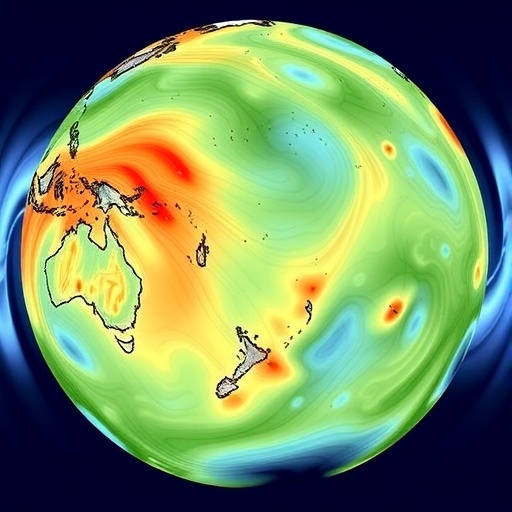In a groundbreaking study published in Nature Communications, an international team of researchers has unveiled new insights into the dynamics of the Southern Ocean during past interglacial periods. Their findings dramatically reshape our understanding of oceanic stratification and its role in past climate states, particularly during the so-called “lukewarm interglacials” that occurred between 430,000 and 340,000 years ago. This research sheds light on the complex interplay between ocean stratification, atmospheric circulation, and global climate system feedbacks, with profound implications for predicting future climate scenarios.
The Southern Ocean, encircling Antarctica, is a critical driver of Earth’s climate due to its role in deep water formation and carbon sequestration. Understanding how its stratification—the layering of water masses with different densities—has varied through geological time is crucial. Historically, the Southern Ocean has been implicated in modulating atmospheric CO2 levels by controlling the exchange of carbon between the deep ocean and the atmosphere. However, the detailed mechanisms governing these processes during interglacial periods have remained elusive until now.
This study leverages high-precision geochemical proxies retrieved from deep-sea sediment cores across the Southern Ocean. By analyzing neodymium isotopic compositions and radiocarbon dating, the team reconstructs past water mass movements and stratification patterns with unprecedented resolution. These isotopic signatures serve as a tracer for ocean water sources and circulation pathways, allowing scientists to detect changes in deep water formation rates and mixing processes during the interglacials.
Central to the research is the discovery that during the lukewarm interglacials—periods characterized by global temperatures slightly warmer than glacial times but cooler than modern Holocene conditions—the Southern Ocean experienced intensified stratification at depth. This enhanced layering reduced vertical mixing between surface and deep waters, which likely dampened the ocean’s ability to release stored carbon into the atmosphere. Consequently, these interglacials maintained relatively low atmospheric CO2 concentrations despite ongoing warming.
The increased stratification appears to be linked to changes in Antarctic ice sheet dynamics and atmospheric circulation patterns. Reduced iceberg discharge and altered wind stress over the ocean surface likely contributed to a more stable water column, inhibiting the usual overturning circulation that brings deep, carbon-rich waters to the surface. This mechanism contrasts with the pronounced overturning and carbon release observed during warmer interglacials closer to present-day conditions, such as Marine Isotope Stage 5e.
Moreover, the study suggests that this deep Southern Ocean stratification had a cascading effect on global climate. By limiting outgassing of CO2, the ocean acted as a more effective carbon sink, helping stabilize atmospheric greenhouse gas levels during these interglacials. This dynamic highlights a previously underappreciated feedback loop between ocean stratification and carbon cycle regulation, emphasizing the Southern Ocean’s pivotal role in mitigating climate change during past warm periods.
Importantly, this research integrates multiple lines of evidence including climate modeling simulations that replicate the environmental conditions inferred from proxy data. These models reinforce the conclusion that changes in stratification patterns fundamentally altered carbon storage and ocean-atmosphere gas exchange. The combined observational and modeling approach lends robustness to the findings and provides a comprehensive framework for examining past and future ocean-climate interactions.
The implications of these findings extend beyond paleoclimate reconstruction. They offer critical context for understanding how current anthropogenic warming might impact Southern Ocean stratification. Modern observations indicate trends towards increased stratification due to surface warming and freshening from Antarctic ice melt. If these processes continue, they could modify the ocean’s capacity to sequester carbon and influence global climate feedbacks in ways reminiscent of the lukewarm interglacial periods.
Furthermore, the study raises questions about the resilience and sensitivity of Southern Ocean circulation under rapid climate change. It underscores the necessity of monitoring oceanic stratification and integrating these dynamics into Earth system models. This improved understanding will enhance predictive capabilities regarding the trajectory of atmospheric CO2 and the potential for abrupt climate shifts driven by ocean feedback mechanisms.
Beyond its scientific contributions, this research exemplifies the power of interdisciplinary collaboration, combining geochemistry, paleoceanography, and climate modeling to decode Earth’s complex climate history. It opens new avenues for investigating the intricate feedbacks between ice sheets, ocean circulation, and the carbon cycle. Such knowledge is crucial in an era where climate change poses unprecedented risks and challenges.
In conclusion, the study by Huang and colleagues illuminates a critical chapter in Earth’s climate narrative—the hidden story of enhanced Southern Ocean stratification during lukewarm interglacials. Their findings provide invaluable insights into how ocean dynamics regulate atmospheric greenhouse gases and global temperatures over millennia. As the climate continues to evolve, unraveling these ancient mechanisms offers a vital lens through which to anticipate the ocean’s role in our planet’s future climate trajectory.
Subject of Research: Southern Ocean stratification and carbon cycle dynamics during past interglacial periods
Article Title: Enhanced deep Southern Ocean stratification during the lukewarm interglacials
Article References:
Huang, H., Fietzke, J., Gutjahr, M. et al. Enhanced deep Southern Ocean stratification during the lukewarm interglacials. Nat Commun 16, 8856 (2025). https://doi.org/10.1038/s41467-025-63938-6
Image Credits: AI Generated




